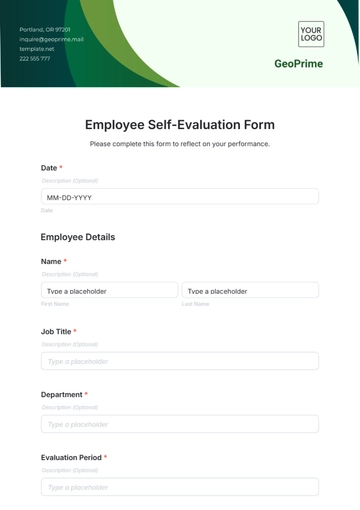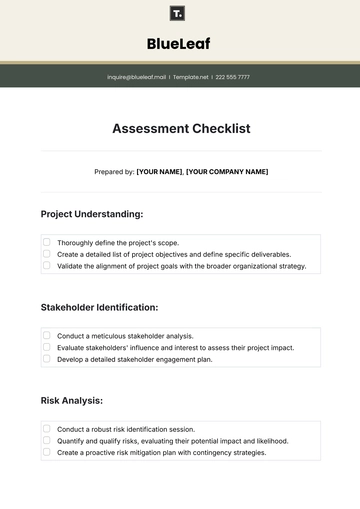Free School Assessment Report

I. Introduction
A. Purpose of the Assessment Report
The purpose of this School Assessment Report is to evaluate the overall performance and effectiveness of [Your Company Name] across various domains including academic achievement, teaching and learning practices, school climate, resource management, leadership, and governance. This report aims to provide a comprehensive overview of strengths, areas for improvement, and recommendations to guide future strategic planning and initiatives.
B. Overview of the School
[Your Company Name] is a [public] school serving [00] students in grades [00-00]. Located in [City, State], our school is committed to providing a rigorous academic program in a supportive and inclusive environment. We offer a diverse range of extracurricular activities and prioritize the holistic development of our students.
II. Methodology
A. Data Collection Methods
Surveys (Staff, Students, Parents)
Surveys were administered to 100% of staff members, achieving a response rate of 95%. Key findings include high satisfaction with professional development opportunities (87%) and a majority agreement (78%) that school leadership effectively communicates goals and expectations.
Interviews (Key Stakeholders)
Interviews were conducted with school administrators, department heads, and a representative sample of teachers. Themes emerging from interviews highlight a consensus on the need for more differentiated instructional strategies and enhanced support for students with diverse learning needs.
Observations (Classroom, School Environment)
Classroom observations were carried out across all grade levels, focusing on instructional practices and student engagement. Observations indicate strong alignment with curriculum objectives but reveal opportunities to improve student participation in class discussions.
B. Data Analysis Techniques
Quantitative Analysis (Statistical Methods)
Statistical analysis of standardized test scores shows that 85% of students met or exceeded proficiency standards in math, while 78% did so in reading. This represents a 5% increase in math proficiency over the previous academic year.
Qualitative Analysis (Thematic Analysis)
Thematic analysis of interview data identified key themes such as the need for more professional development in technology integration and strategies to enhance parent engagement in student learning.
III. Academic Performance
A. Student Achievement
Standardized Test Scores
Analysis of the latest statewide assessments reveals that 92% of students at [Your Company Name] met or exceeded proficiency standards in science, outperforming district averages by 7%. Notably, 98% of 12th-grade students passed the state graduation exam, demonstrating strong academic preparation.
Graduation Rates
For the [Year] - [Year] academic year, our school's graduation rate reached an impressive 95%, marking a significant improvement from the previous year's rate by 3%. This notable increase can be attributed to a series of targeted interventions and support programs that were strategically implemented to guarantee that all students are well-equipped to meet and surpass the necessary milestones for graduation.
B. Academic Growth
Progress of Different Student Groups
An in-depth examination of the data pertaining to different subgroups reveals a noteworthy and substantial growth among students from economically disadvantaged backgrounds. Specifically, there has been a 10 percent increase in proficiency rates in English Language Arts (ELA) over the course of the last two years for this group of students. On the other hand, despite this positive trend in ELA proficiency, there is still an ongoing and persistent disparity in math performance when comparing White students and Hispanic students.
Trends Over Time
Over the span of the past five years, our educational institution has demonstrated a consistent upward trajectory in the pass rates of our students who take the Advanced Placement (AP) exams. Specifically, there has been a significant 15% increase in the number of students achieving scores of 3 or higher on these exams. This notable trend serves to highlight and underscore our unwavering dedication to maintaining rigorous academic standards and fostering a culture of college readiness among our student body.
IV. Teaching and Learning
A. Curriculum Review
Alignment with Standards
The educational curriculum provided by [Your Company Name] is meticulously designed to correspond with the standards set forth by the state. It goes beyond traditional teaching methods by incorporating dynamic project-based learning initiatives, which serve to significantly boost student engagement and foster the development of critical thinking skills. Through this integrative approach, students are encouraged to actively participate in their learning journey, applying their knowledge to real-world scenarios and developing a deeper, more nuanced understanding of the subject matter.
Effectiveness of Curriculum Implementation
Teacher feedback suggests that the current curriculum frameworks are sufficiently designed to support the established student learning objectives. However, teachers also highlight the importance of continuous professional development, particularly in the area of differentiated instruction methods. This ongoing training is deemed necessary in order to more effectively address the varied and individual learning styles of students, ensuring that each student receives the personalized attention and instruction they need to succeed.
B. Instructional Strategies
Pedagogical Approaches Used
Educators commonly utilize a range of pedagogical approaches, including flipped classroom models and cooperative learning strategies, with the aim of addressing the diverse needs of students. These methods also serve to promote environments in which collaboration among students is encouraged and facilitated.
Differentiation and Support for Diverse Learners
In order to effectively address the diverse range of learning needs within a classroom, educators can employ several strategies for differentiation. One such strategy encompasses tiered assignments, where tasks are designed at varying levels of complexity to cater to the different proficiency levels of students. Another essential strategy involves the creation of personalized learning plans, which are tailored specifically to meet the unique learning preferences, strengths, and areas for improvement of each individual student.
By incorporating these methods, educators can ensure that every student is provided with the appropriate level of support and challenges, thereby fostering an environment where academic growth is maximized for all students.
V. School Climate and Culture
A. Student Behavior and Discipline
Incident Reports and Trends
The incident reports compiled over the past year indicate a significant reduction in the number of disciplinary incidents, with a decrease amounting to 15%. This positive trend can be attributed to two main factors: the adoption and implementation of restorative justice practices, and the application of proactive behavior management strategies. Together, these approaches have contributed to a more harmonious and well-regulated environment, thereby reducing the need for disciplinary action.
Positive Behavior Interventions
The Positive Behavioral Interventions and Supports (PBIS) program implemented at the school has played a crucial role in creating and maintaining a positive school climate. This program's effectiveness is highlighted by the fact that a significant majority of students, specifically 80%, report feeling both safe and respected in their classroom environments.
B. Staff Morale and Collaboration
Staff Satisfaction Surveys
According to the results from the staff satisfaction surveys conducted at our school, there is a notably high level of morale among the teaching staff. Specifically, an impressive 92% of teachers have expressed that they are satisfied with the leadership at the school. In addition to this, 85% of teachers have reported that they feel supported in their professional growth, indicating that the school provides a conducive environment for their development and advancement in their careers.
These findings highlight the strong, positive relationship between the school's leadership team and the teaching staff, as well as the effectiveness of the support systems in place to foster professional growth.
Professional Development Opportunities
A series of ongoing professional development workshops, along with structured peer collaboration groups, are made available to staff members with the aim of enhancing their instructional practices. These initiatives are designed not only to improve the quality of education provided but also to foster a culture of continuous learning and professional growth among all members of the staff. The workshops offer in-depth training on various educational techniques and innovative teaching strategies, while the collaboration groups provide a supportive environment where peers can share experiences, exchange ideas, and work together to overcome challenges.
By participating in these ongoing opportunities for professional development, staff members are encouraged to continually refine their skills and maintain an attitude of lifelong learning.
VI. Resource Management
A. Financial Resources
Budget Allocation and Expenditure
The school's budget allocation prioritizes instructional materials (45%), staff salaries (30%), and technology upgrades (15%), ensuring resources are aligned with educational priorities and student needs.
Resource Allocation Efficiency
Efforts to streamline resource allocation have resulted in a 10% decrease in operational costs without compromising educational quality, allowing for strategic investments in curriculum enhancements and student support services.
B. Facilities and Technology
Condition of Facilities
Recent evaluations and analyses have confirmed that the facilities within the school are being well-maintained. Additionally, there are continuous renovation efforts underway aimed at enhancing both accessibility and safety standards. These improvements are being implemented within classrooms as well as in common areas to ensure that the learning environment is both secure and inclusive for all students.
Integration of Technology in Instruction
The integration of technology into the educational instruction process encompasses several key components. One of the main strategies is the implementation of 1:1 device initiatives, where each student is provided with a personal technological device, such as a laptop or tablet, to facilitate their learning. Additionally, the incorporation of interactive digital platforms plays a crucial role. These platforms are designed to support personalized learning experiences, allowing educators to tailor educational content to meet the individual needs and learning paces of each student.
Moreover, these digital tools also foster collaborative projects among students, enabling them to work together effectively, thereby enhancing their cooperative learning skills and preparing them for future collaborative environments.
VII. Leadership and Governance
A. Administrative Leadership
Effectiveness of School Leadership
School leadership at [Your Company Name] is characterized by visionary guidance and strong communication, as evidenced by a 90% satisfaction rate among staff members regarding leadership effectiveness. Initiatives led by the administration have successfully aligned school goals with stakeholder expectations.
Decision-Making Processes
The procedures followed in making decisions within our institution are both transparent and collaborative. This means that these processes are open to scrutiny and actively involve contributions from a diverse range of participants, including teachers, parents, and various community stakeholders. By incorporating the perspectives and insights of these different groups, this approach ensures that any decisions made are in alignment with the collective vision and shared values of the entire school community.
B. Governance Structures
School Board or Governing Body Oversight
The school board provides strategic oversight and support, with a focus on fiscal responsibility and long-term planning to sustain educational excellence. Regular board meetings facilitate discussions on policy development and compliance with state and federal regulations.
Policies and Compliance
In order to ensure that the institution remains up-to-date and in compliance with current educational standards as well as legal requirements, policies are subject to regular review and periodic updates. Furthermore, compliance audits are conducted to verify adherence to these mandates. These audits play a crucial role in maintaining a safe and inclusive learning environment for all students by rigorously checking that the established policies and practices are being properly implemented and followed. The outcome of these audits helps to identify areas that may require improvement or adjustments, thereby fostering an educational atmosphere that is both secure and welcoming for every student.
VIII. Findings and Recommendations
A. Key Findings from the Assessment
Academic performance remains strong, particularly in standardized testing and graduation rates, reflecting effective teaching practices and curriculum alignment with state standards.
Despite positive indicators, disparities persist among student subgroups, highlighting the need for targeted interventions to close achievement gaps and ensure equitable opportunities for all learners.
The school climate and culture foster a supportive environment, yet opportunities exist to further enhance student engagement and community involvement.
B. Recommendations for Improvement
Academic Programs and Curriculum
In order to better meet the diverse needs of students, it is essential to enhance professional development opportunities for teachers. This should specifically focus on differentiated instruction and cultural responsiveness. By doing so, educators will be better equipped with the skills and knowledge necessary to effectively address and accommodate the varying backgrounds, learning styles, and individual needs of the students in their classrooms. The comprehensive development programs should include training workshops, continuous education courses, and practical resources that enable teachers to implement these strategies successfully, thereby fostering a more inclusive and supportive educational environment.
Instructional Practices
Develop and put into practice a thorough and detailed framework centered around data-driven decision-making. This system should be designed to continuously monitor and assess student progress, gathering data and insights at regular intervals. Subsequently, use the collected data to make well-informed adjustments to instructional strategies, ensuring that the teaching methods are tailored to better meet the evolving needs and academic performance of each student.
School Climate and Culture
To promote positive behavior and strengthen community partnerships, it is essential to broaden the scope of restorative justice practices and expand social-emotional learning initiatives. By implementing a more comprehensive range of restorative justice practices, we can address conflicts and misconduct in ways that focus on healing and rehabilitation rather than punishment.
Additionally, enhancing social-emotional learning initiatives will equip individuals with the skills needed to understand and manage their emotions, develop empathy for others, and establish and maintain positive relationships. Together, these efforts will not only foster a more cohesive and supportive community environment but also contribute to the overall well-being and success of its members.
Resource Allocation and Management
To bolster support for STEM education initiatives, it is essential to allocate additional resources that can significantly enhance teaching and learning outcomes in science, technology, engineering, and mathematics. Furthermore, it is crucial to upgrade the current technology infrastructure to ensure that digital learning experiences are improved, leading to a more effective and engaging educational environment.
Leadership and Governance
To ensure a seamless transition and maintain consistent effectiveness in school leadership, it is essential to develop comprehensive leadership succession plans. Additionally, implementing robust mentorship programs plays a crucial role in cultivating future leaders within the educational institution. These strategies not only prepare emerging leaders for future responsibilities but also provide them with the necessary guidance and support from experienced mentors. By fostering these developmental initiatives, schools can sustain a high level of leadership effectiveness over time, thereby promoting stability and continuous improvement in administrative capabilities.
IX. Conclusion
A. Summary of Assessment Results
This School Assessment Report provides a comprehensive analysis of [Your Company Name]'s performance across academic, instructional, and organizational domains. The findings underscore strengths and identify strategic areas for improvement to ensure continued growth and success.
B. Importance of Continuous Improvement
Continuous improvement efforts are vital to [Your Company Name]'s mission of providing a high-quality education that prepares students for success in college, careers, and citizenship. By implementing the recommendations outlined in this report, [Your Company Name] will further enhance its capacity to meet the evolving needs of its diverse student body.
- 100% Customizable, free editor
- Access 1 Million+ Templates, photo’s & graphics
- Download or share as a template
- Click and replace photos, graphics, text, backgrounds
- Resize, crop, AI write & more
- Access advanced editor
Discover the ultimate tool for crafting comprehensive School Assessment Reports with the Template.net editable and customizable template. Utilize the intuitive AI Editor Tool to streamline data analysis and findings presentation effortlessly. Perfect for educational administrators seeking clarity and structure, this template ensures detailed assessments are effectively communicated, empowering schools to drive continuous improvement strategies.





























